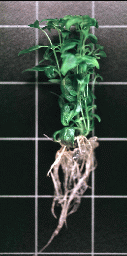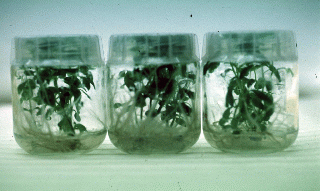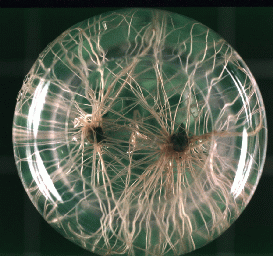Dpto. Biología Vegetal
E.U.I.T. Agrícola
Universidad Politécnica de Madrid
E-28040 Madrid, Spain

|
| Regenerated plantlet Cultivar "Floral Carpet" Full size picture (99855 Bytes) |
|---|

|
| Multiple shoot formation, Cultivar "Floral Carpet", Full size picture (109270 Bytes) |
|---|
Several works have been carried out on the in vitro culture of snapdragon cultivars. A large part of them deal with callus formation, protoplast isolation and plant regeneration from callus cultures, whereas others report on a direct way of micropropagation based on multiple shoot formation and the rooting of the formed shoots. The different developmental responses are obtained culturing the explants in nutritious media with different combinations and concentrations of auxins and cytokinins.
Explant material, methods and results of published works on the
in vitro culture of Antirrhinum majus
can be summarized as follows:
|
| ||||||
| Leaf and stem segments | Murashige & Skoog (1962) | 5.8 | 30 | 8 | 1 (2,4-D) | Callus formation | Rao et al. (1976) |
| Stem internode | Sangwan & Harada (1975) | 5.5 | 20 | 6 | 0.25 NOA | Callus formation | Pfister & Widholm (1984) |
| Seedling root | Sangwan & Harada (1975) | 5.5 | 20 | 6 | 0.25 (NOA) | Callus formation | Pfister & Widholm (1984) |
| Shoot tips | Murashige & Skoog (1962) | 5.7 | 30 | 7 | 1 (BAP) | Callus formation | Atkinson et al. (1989) |
| Seedling root | Sangwan & Harada (1975) | 5.5 | 20 | 6 | 0.25 (NOA) | Shoot regeneration via callus | Pfister & Widholm (1984) |
| Root callus | Syono & Furuya (1972) | 5.8 | 30 | Liquid | 0.4 (2,4-D) | Shoot regeneration via callus | Pfister & Widholm (1984) |
| Stem internode | Poirier-Hamon et al. (1974) | 5.5 | 20 | 6 | 0.5-2 (2,4-D) | Embryoids via callus | Poirier-Hamon et al. (1974) |
| Protoplasts | Poirier-Hamon et al. (1974) | --- | 20.5 | Liquid | 1 (2,4-D) + 0.5 (BAP) | Embryoids via colonies | Poirier-Hamon et al. (1974) |
| Internode stem segments | Nitsch et al (1967) | 5.5 | 20 | 7 | 0.25-0.5 (NOA) or
0.5 (2,4-D) | Friable green callus embryogenesis | Sangwan & Harada (1975) |
| Callus | Murashige & Skoog (1962) | 5.8 | 30 | 8 | 1 (2,4-D) + 0.5 (BAP) | Indirect embryogenesis | Rao et al. (1976) |
| Internode stem segments | Nitsch et al. (1967) | 5.5 | 20 | 7 | 2 (IAA) + 4 (Kin) | Roots & multiple shoots | Sangwan & Harada (1975) |
| Shoot tips | Murashige & Skoog (1962) | 5.7 | 30 | 7 | 1 (BAP) | Multiple shoots | Atkinson et al. (1989) |
| Nodal segments | Murashige & Skoog (1962) | 5.8 | 30 | 8 | 0.5 (NAA) + 1 (BAP) | Multiple shoots | González-Benito et al.
(1996) |
| Shoots | Bourgin & Nitsch (1967) | 5.5 | 10 | 8 | None | Rooted plantlets | Pfister & Widholm (1984) |
| Shoots | Murashige & Skoog (1962) | 5.8 | 30 | 8 | None | Rooted plantlets | González-Benito et al.
(1996) |

|
|
Root development, Cultivar "Floral Carpet" Full size picture (127311 Bytes) |
|---|
The presence of cytokinins (kinetin or BAP) in the medium seems
to be favourable for multiple shoot formation (Atkinson et
al., 1989; González-Benito et al., 1996). According
to Newbury et al. (1992) less callus was formed when shoot
tips cultured on 1mg/l BAP, were excised from older plants (greenhouse
grown plants vs. 48 day old seedlings). In González-Benito
et al. (1996), no callus growth was observed on most media
tested.
Rooting is achieved when shoots are cultured in the absence of
plant growth regulators (Sangwan & Harada, 1975; Pfister &
Widholm, 1984; González-Benito et al., 1996). In
González-Benito et al. (1996), the use of IBA at
concentrations of 2 mg/l and higher was detrimental to root formation.
The last stage of micropropagation, that is the acclimatization
to ex vitro conditions and transfer to the greenhouse,
which is critical in many species, can be successfully achieved
in snapdragon. For instance, in González-Benito et
al. (1996), a 90% survival was obtained when rooted vitroplants
were transferred to pots with an autoclaved 3 peat : 1 vermiculite
v/v mixture. The potted plants were kept in fully enclosed propagators
with transparent lids and the windows of the micropropagators
were opened for increasing periods of time each day for 15 days,
before being transferred to the greenhouse.
A similar general pattern of response has been found when different
snapdragon cultivars have been cultured in the same media, although
some differences occur (Newbury et al. 1992). Moreover,
the same can be said with regard to the micropropagation of wild
types of snapdragon (Antirrhinum majus ssp. barrelieri
and A. microphyllum) (González-Benito et al.,
(1996).
A general protocol for the in vitro propagation of snapdragon
would consist of the following: Nodal segments or shoot tips from
"mother plants” can be used as explants. The explants
can then be cultured on MS + 1 mg/l BAP for multiple shoot formation.
Root formation of isolated shoots can take place on MS medium
without growth regulators. Initially high moisture conditions
are needed for the acclimatization of vitroplants before transfer
to greenhouse.
The use of microproopagation techniques in snapdragon may be especially best suited for the propagation of triploid cultivars where sexual propagation is not possible.
Atkinson, N.J. et al. (1989) Regeneration of plants from
Antirrhinum majus L. callus. Plant Cell Tiss. Organ.
Cult. 17:59-70
Atkinson, N.J. et al. (1991) In vitro adventitious
root induction in Antirrhinum majus L. Plant Cell Tiss.
Organ. Cult. 27:77-79
Bourgin, J.P. & Nitsch, J.P. (1967) Production of haploid
Nicotiana from excised stamens. Ann. Physiol. Vég.
9:377-382.
González-Benito et al. (1996) Micropropagation of
comercial and wild genotypes of snapdragon (Antirrhinum spp.)
Journal of Horticultural Science 71:11-15
Murashige, T. & Skoog, F. (1962) A revised medium for rapid
growth and bio-assays with tobacco tissue cultures. Physiol.
Plant. 15:473-497
Newbury, H.J. et al. (1992) Micropropagation of snapdragon
(Antirrhinum majus L.). In: Biotechnology in agriculture
and forestry. High tech and micropropagation . IV. (Bajaj,
Y.P.S., Ed.). Springer Verlag, Berlin, 19-33
Nitsch, J.P., Nitsch, C. Rossini, L.M.E. and Bui Dang Ha, D. (1967)
The role of adenine in bud differentiation. Phytomorph.
17:446-453
Pfister, J. M. & Widholm, J.M. (1984). Plan regeneration from
snapdragon tissue cultures. Hort Science, 19:852-854
Poirier-Hammon, S. et al. (1974). Culture of mesophyll
protoplasts and stem segments of Antirrhinum majus (snapdragon):
growth and organization of embryoids. Journal of Experimental
Botany. 87: 752-60
Rao, P. S. etal. (1976) Gamma radiation and hormonal factors controlling
morphogenesis in organ cultures of Antirrhinum majus L.
cv. Red. Majestic Chief. Z. Pflanzenphysiol., 80:144-152
Sangwan, R.S. & Harada, H. (1975) Chemical regulation of callus
growth, organogenesis, plant regeneration, and somatic embryogenesis
in Antirrhinum majus tissue and cell cultures. Journal
of Experimental Botany.26:868-81
Sangwan, R. S. et al. (1987) In vitro culture of
shoot-tip meristems in some higher plants. Acta Hort. 212:
661-666
Sangwan, R.S. & Sangwan, J.S. (1990). Snapdragon. In:
Handbook of plant cell culture. V. Ornamental species.
(Ammirato, P.V., Evans, D.A., Sharp, W.R., Bajaj, Y.P.S., Eds).
Springer Verlag, New York, 744-62
Syono, K. & Furuya, T. (1972) The differentiation of Coptis plants in vitro from callus cultures. Experientia 28:236
2,4-D: 2,4 dichlorophenoxyacetic acid
BAP: 6-benzylaminopurine
IAA: 3-indoleacetic acid
IBA: 3-indolebutiric acid
Kin: kinetin; 6-furfurylaminopurine
NAA: 1-naphtylacetic acid
NOA: 2-naphthoxyacetic acid